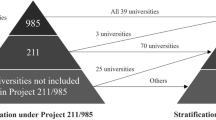Abstract
The author argues that greater attention should be paid to different levels of authority in the study of globalization and higher education, especially the understructure or disciplinary units. Using Marginson and Rhoades' concept of ‘Glonacal,’ he argues that universities operate on local, national, and global dimensions, but also that the orientation towards these dimensions may be quite different depending on the level of authority within the higher education system. He proposes a global higher education matrix that focuses on the orientation of different levels of authority to each of the glonacal dimensions. This matrix might provide a useful framework for studying the complex, multi-layered interactions and inter-relationships associated with globalization and internationalization.
Similar content being viewed by others
Notes
For example, the Times Higher Education Supplement and the Shanghai Jiao University rankings.
Based on the 2007 ranking of the Academic Ranking of World Universities Project, Shanghai Jiao University, available at http://ed.sjtu.edu.cn/rank/2007/ARWU2007_Top100.htm. The undergraduate enrolment at each of the top five institutions was obtained from institutional and other reference websites.
At some institutions there are multiple levels of international partnerships and initiatives. For example, the university may be involved in a range of international organizations and have partnership arrangements with peer institutions. Local units may also be involved in international organizations, or have a separate set of partnership arrangements with international peers. For example, the University of Toronto is now a member of the World Universities Network, and the Ontario Institute for Studies in Education of the University of Toronto is a member of an international alliance of research-intensive faculties of education. These international connections co-exist at multiple levels of the higher education system.
References
Amaral, A., Jones, G.A. and Karseth, B. (2002) ‘Governing Higher Education: Comparing National Perspectives’, in A. Amaral, G.A. Jones and B. Karseth (eds.) Governing Higher Education: National Perspectives on Institutional Governance, Dordrecht: Kluwer Academic Publishers, pp. 279–298.
Baker, D.P. and Lenhardt, G. (2008) ‘The institutional crisis of the German research university’, Higher Education Policy 21 (1): 49–64.
Becher, T. (1989) Academic Tribes and Territories: Intellectual Enquiry and the Cultures of the Disciplines, Milton Keynes: The Society for Research into Higher Education and Open University Press.
Clark, B.R. (1983) The Higher Education System: Academic Organization in Cross-National Perspective, Los Angeles: University of California Press.
Clark, B.R. (1995) Places of Inquiry: Research and Advanced Education in Modern Universities, Los Angeles: University of California Press.
Connell, G.E. (1987) Renewal 1987: A Discussion Paper on the Nature and Role of the University of Toronto, Toronto: University of Toronto.
Fisher, D., Rubenson, K., Bernatchez, J., Clift, R., Jones, G., Lee, J., MacIvor, M., Meredith, J., Shanahan, T. and Trottier, C. (2007) Canadian Federal Policy and Post-Secondary Education, Vancouver, BC: Centre for Policy Studies in Higher Education and Training, University of British Columbia.
Jones, G.A. (2006) ‘Canada’, in J.F. Forest and P.G. Altbach (eds.) International Handbook of Higher Education, Dordrecht: Springer, pp. 627–645.
Jones, G.A., McCarney, P.L. and Skolnik, M.L. (2005) ‘Introduction’, in G.A. Jones, P.L. McCarney and M.L. Skolnik (eds.) Creating Knowledge, Strengthening Nations: The Changing Role of Higher Education, Toronto: University of Toronto Press, pp. 3–18.
Jones, G.A. and Young, S. (2004) ‘Madly Off in All Directions: Higher Education, Marketization, and Canadian Federalism’, in P. Teixeira, B.B. Jongbloed, D. Dill and A. Amaral (eds.) Markets and Higher Education: Rhetoric or Reality?, Dordrecht: Kluwer Academic Publishers, pp. 185–205.
Kells, H.R. (1992) Self-Regulation in Higher Education, London: Jessica Kingsley Publishers.
Kerr, C. (2001) The Uses of the University, 5th edn., Cambridge: Harvard University Press.
Knight, J. (2004) ‘Internationalization remodeled: definitions, rationales, and approaches’, Journal for Studies in International Education 8 (1): 5–27.
Knight, J. (2006) ‘Internationalization of higher education: new directions, new challenges’, 2005 IAU Global Survey Report, Paris: International Association of Universities.
Marginson, S. (2006) ‘Globalisation, the “idea of a university” and its ethical regimes’, Higher Education Management and Policy 19 (1): 31–46.
Marginson, S. (2007) ‘The public/private divide in higher education: a global revision’, Higher Education 53 (3): 307–333.
Marginson, S. and Rhoades, G. (2002) ‘Beyond national states, markets and systems of higher education: a glonacal agency heuristic’, Higher Education 43 (3): 282–309.
Marginson, S. and Sawir, E. (2006) ‘University leaders' strategies in the global environment: a comparative study of Universitas Indonesia and the Australian National University’, Higher Education 52 (2): 343–373.
Mohrman, K. (2008) ‘The emerging global model with Chinese characteristics’, Higher Education Policy 21 (1): 29–48.
Newsweek International Edition. (2006) ‘Complete list: the top 100 global universities’, 13 August, http://www.msnbc.msn.com/id/14321230.
Oleksiyenko, A. (2008) ‘Global portfolios and strategic international partnerships of a major research university’, Unpublished doctoral dissertation, University of Toronto.
Sadlak, J. and Liu, N.C. (eds.) (2007) The World-Class University and Ranking: Aiming Beyond Status: Higher Education for a Knowledge Society, UNESCO, European Centre for Higher Education (CEPES), Cluj-Napoca: Presa Universitara Clujeana.
Shanahan, T. and Jones, G.A. (2007) ‘Shifting roles and approaches: government coordination of postsecondary education in Canada from 1995 to 2006’, Higher Education Research and Development 26 (1): 31–43.
Acknowledgements
An earlier version of this paper was presented at the World Universities Network seminar entitled ‘Realizing the Global University’, London, 14–15 November 2007. The author is grateful for the feedback that was provided by seminar participants.
Author information
Authors and Affiliations
Rights and permissions
About this article
Cite this article
Jones, G. Can Provincial Universities be Global Institutions? Rethinking the Institution as the Unit of Analysis in the Study of Globalization and Higher Education. High Educ Policy 21, 457–468 (2008). https://doi.org/10.1057/hep.2008.17
Published:
Issue Date:
DOI: https://doi.org/10.1057/hep.2008.17




